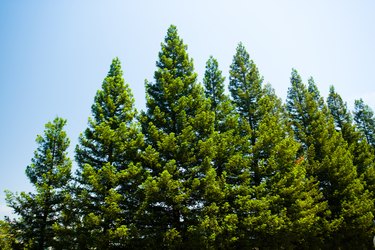Things You'll Need
Shovel
Core aerator
Sulfur
Rake
Garden hose
Sprinkler

As pine trees age, they deposit bark and pine needles over their soil around the base of the tree. Over time, this soil can build up into a thick layer. As this natural mulch decomposes, it can become very acidic, making the soil beneath it acidic as well. Because pines prefer neutral soil, and because 90 percent of their roots are in the top 12 inches of the soil, the acid in the soil can inhibit a pine tree's development. Fortunately, neutralizing soil under a pine tree is not complicated.
Step 1
Test your soil to determine the pH level. Contact your local county extension service to find out where to submit a soil sample, and the preferred method of testing the soil. A soil test will tell you what amendments to add to the soil to raise the pH. Typically lime is recommended to raise the pH of soil.
Video of the Day
Step 2
Set the core depth on a soil aerator by turning the depth control knob on the aerator. The aerator will remove cores of soil and place holes in your turf without damaging the roots below it. Set your aerator no more than 1 inch deep to avoid damaging shallow pine tree roots.
Step 3
Turn the core aerator on by pulling the starter rope on your machine. Push the aerator around the tree in sections. Be careful not to damage the trunk or visible roots of the tree as you aerate the soil.
Step 4
Spread lime over your soil with a rake and shovel. Use the amount recommended by the soil test in step 1.
Step 5
Water your soil with a garden hose to wash the sulfur into the cores.
Tip
Rent a core aerator from your local garden center. A core aerator removes plugs of soil from around your tree’s root zone without damaging the roots. Not all pine trees prefer neutral soil. Trees such as spruce prefer acid soil. Make certain that your pine is a species that prefers neutral soil before neutralizing the soil.
Video of the Day